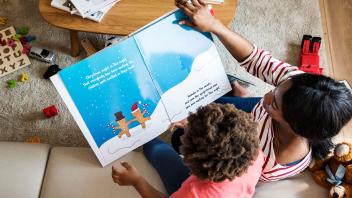Sometimes parents of beginning readers wonder if their child is on track with reading. They don’t understand why their child can’t read a word today they were able to read yesterday. They think their child reads too slowly. They grumble that their child only wants to read the same book over and over again.
Most beginning readers are inconsistent. They may know a word one day but not the next. They may read a particular word correctly on one page, but they have to stop and sound it out again on the next page. When you listen to a beginning reader, you hear short, choppy words with little attention to punctuation. Sometimes a new reader can tell you very little about what they just read.
At the beginning stage of reading, all of these reading behaviors are to be expected. Beginning readers are building their fluency. This means they’re working to make several skills, like matching a letter to a sound and decoding, more smooth, accurate and automatic. Without fluency, each word must be decoded, and that takes time and energy. This means that other reading behaviors like reading with expression and comprehension have less of a focus.
When reading with a beginning reader, it’s important to do the following:
- Give them time to read. Reading is a skill, and like many other skills, it takes time to develop. A beginning reader should spend at least 20 minutes a day reading to or with someone. The books read during this time should be relatively easy for your child.
- Let them reread the same books. Rereading the same words over and over again helps build fluency. Over time, you’ll notice that your child will stop less often to decode words.
- Encourage attention to the print. If your child is stuck on a word, help him look at the first letter(s) and encourage him to sound it out. If it’s a difficult word, or one that can’t be sounded out, simply supply the word and continue reading.
- Take turns reading. By listening to your fluent reading, your child will hear what good readers sound like. After you’ve read a short passage, ask your child to reread the same passage. This provides a chance for her to practice reading with expression.
- Have realistic expectations. For example, students should be reading approximately 60 words per minute correctly by the end of first grade, and 90-100 words per minute correctly by the end of second grade. Your child’s teacher can help you learn your child’s reading rate.
It’s important to nurture your beginning reader in a way that helps make reading a daily habit and a lifelong love. By being aware of what’s normal for a beginning reader, and by knowing how to help them progress, you’re sure to instill those qualities in your reader.
